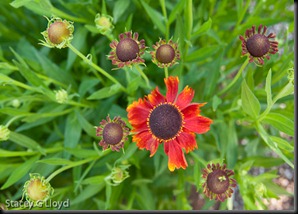You may have noticed a lot images using texture overlays as of late. You take two images overlay them and blended them together – a nicely textured rock overlaid and with a flower for example. But if you go back to the writings of Freeman Patterson, he discovered that you could create textured images using multiple exposures where you mix images of different subjects along the way. This is probably best explained through an example – like the opening blog image.
Two types of flowers have been combined via multiple exposures to create the blog image. A total of seven exposures went into this image. As in the past, this has all been done in camera (a Nikon feature, but you can recreate this using layers in Photoshop).
 First a background pattern or texture if you will was laid down by taking the first five exposures of the Blue Star Thistle shown on the
First a background pattern or texture if you will was laid down by taking the first five exposures of the Blue Star Thistle shown on the  left. The five images combine into a background image that looks something like the next image. Note that you can create texture images like this
left. The five images combine into a background image that looks something like the next image. Note that you can create texture images like this  and use it to blend with other images you may already have.
and use it to blend with other images you may already have.
Second, two additional exposures were take of the Helen’s flower shown here. Note that you may need to up the EV +1 for these last two exposures to bring them out a bit more.
Hints:
- Choose the colors of your material carefully so they work together. Here we have a classic blue/orange combination.
- For the background (thistle in this case), try to create a nice even texture by thinking ahead about the framing of the multi-exposures.
- Post process for contrast, saturation, etc as desired. I did little to not adjustments on the blog image.
Have fun!






2 Comments
Awesome idea Stacey! Takes what Tony Sweet introduced me (us) to on Whidbey at the Bayview nursery. Your idea has expanded the possibilities for me. Thanks!
Your welcome Penelope – glad to know you are following the blog. I would like to take the credit, but it was Freeman's idea. I am just reviving it. I would highly recommend his book, "Photo Impressionims and the Subjective Image".